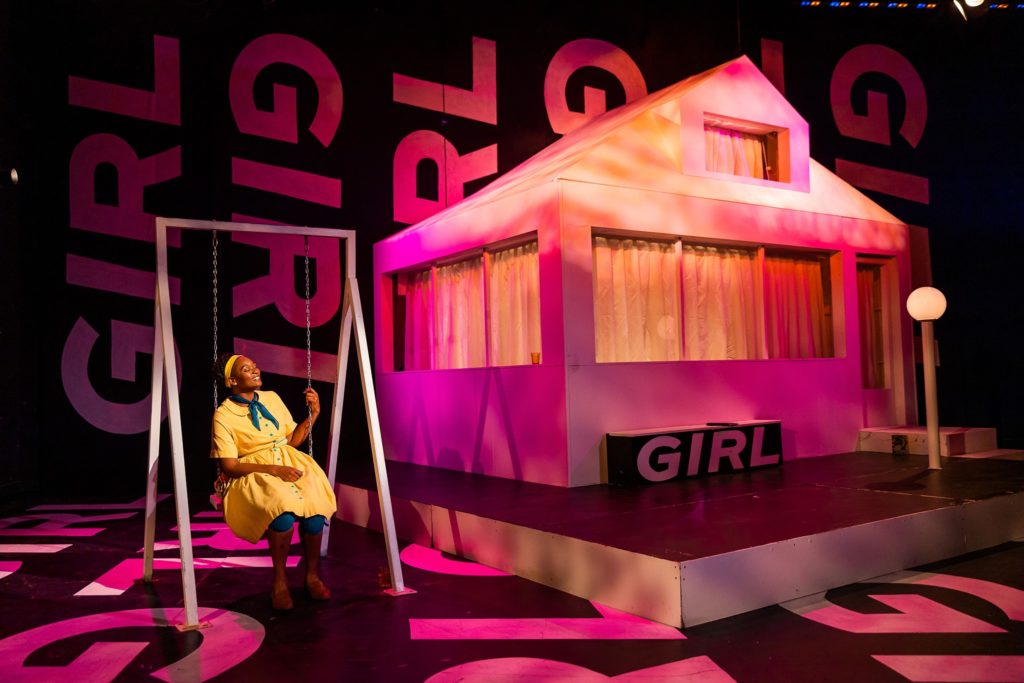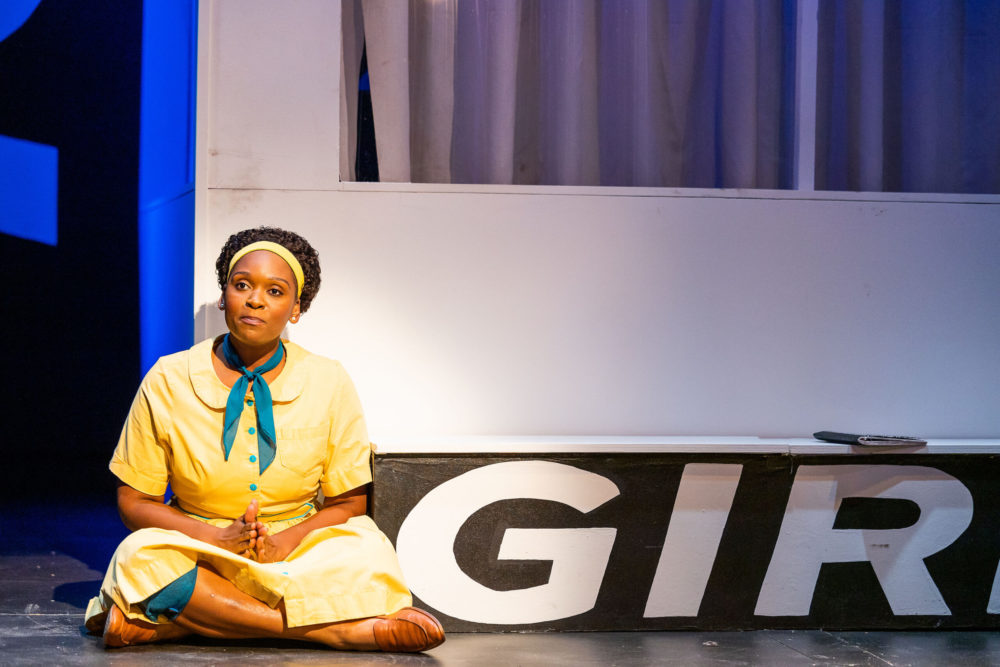
Photo credit to Nile Scott; Image shows Jasmine M. Rush in Queens Girl in the World, sitting on a swing. Behind her, the set, which predominantly features a large, white house, is lit with a mixture of purple and orange lights. In the scene, Jasmine’s character is smiling happily.
Co-produced by The Nora@Central Square Theater, The Front Porch Arts Collective, and The Hangar Theater
Written by Caleen Sinnette Jennings
Directed by Dawn M. Simmons
Performed by Jasmine M. Rush
September 30 – October 31, 2021
Streaming link
Central Square Theater
450 Massachusetts Avenue
Cambridge, MA 02139
CST on Facebook
Critique by Kitty Drexel
Trigger warning: abuse, grooming
CAMBRIDGE, Mass. — There is a practice in the UK that I absolutely love: you can purchase a copy of the show you’re there to see at the bar. Going to see a new play? Buy a copy of it with your Malbec. Attending the show alone? Peruse your new copy while sipping Chardonnay at intermission. (Or Diet Coke if you’re reviewing.)
In the case of last night’s Queens Girl in the World, I wanted to buy and immediately read the entire Queens Girl Trilogy: Queens Girl in the World, Queens Girl in Africa, Queens Girl: Black in the Green Mountains. Character Jacqueline Marie Butler, written by Caleen Sinnette Jennings, is so captivating I want to know more about her.
Jacqueline Marie Butler (Jasmine M. Rush) says she is “two completely different people in one tired body.” In Queens Girl in the World, the twelve year old wrestles puberty, the 60’s civil rights history in its making, and boys. Her train rides from Queens to her liberal, predominantly-Jewish private school in Greenwich Village are trips from one world to another.
The United States is grappling with its racism. The war is playing out on the Black bodies of its citizens, Butler included. She advances at the same pace as the civil rights movement.
Queens Girl in the World is a semi-biographical story about a girl grooving to Motown as she wrestles with society’s demands, her own heart and the American racial divide. It takes place during the 1960s but its messages are still relevant.
Jasmine M. Rush as Jacqueline Marie Butler is a joy to watch. Her earnest performance as Butler is sincere and heartwarming. We laugh as Rush portrays a list of disparate characters from Butler’s elegant mother, Grace Loughton Butler, to Earl the teenage boy down the road, to Leah Hoffman, Butler’s eccentric teacher with the heavy Brooklyn accent. Rush grants each autonomy and the honor they deserve.
Women-identifying folx will relate to Butler’s struggles of identity. People who don’t identify as a woman may learn from this performance. It is incredibly difficult to be a young woman. Empathy is necessary.
Rush’s performance is what makes this play approachable to a wide audience. She’s generous with her energy and transparent in her objectives. She is respectful to this child’s confusion. The world never stops being confusing and frustrating.
The canary yellow and bright blue costume by Miranda Kau Giurleo gives Jacqueline Marie Butler an oomph of pizzazz. This is a little girl with persistent positivity.
Playwright Jennings writes Butler with sincerity and honesty. Summaries describe this play as “coming of age.” Butler doesn’t come of age so much as maturity is forced upon her. Jennings knows that young women have to grow up fast in this world. Faster than white girls. Black girls have an uphill battle with a sharper incline coming and going. Jennings’ adventures for Butler reflect this truth.
A short Google search tells me that the plays aren’t easily acquired online. I imagine that the second and third plays are just as readable as the first sounds. They could be perfect for a young, voracious reader in their teens. They could facilitate bigenerational conversations about changing bodies in a changing world. Adulthood is difficult, but teenagerhood is more so.

Jasmine M. Rush in “Queens Girl in the World” at Central Square Theater. (Courtesy Nile Scott Studios)
The Queens Girl in the World set by Diggle is arresting. It grabs your eyes in their sockets and gives them a shake. Sound design by Greg Smith and lighting design by Kevin Dunn assist in creating this world for the stage.
The Central Square black box is segmented with columns of “GIRL” in bold white typeface on the back wall and stage floor. A white two-story house with opaque, white curtains squats in the center of the room. A black storage container and bench reading “GIRL” is square against its front. A white swing is to its left. Perhaps this play is about a girl? Metaphors abound.
A warning to survivors: this play contains a scene in which a trusted adult molests a child. We don’t see it. It is discussed. Art reflects life. Some parts will never be pretty. We discuss it so we can prevent further abuse, so young people know that it isn’t their fault.
As a survivor of similar abuse, I saw myself in this moment. I was lucky; I didn’t experience PTSD symptoms. A warning before the show would
Should you also be a survivor, please consider your own needs before attending. Your health is important. It is not shameful to be a survivor. The shame rests solely on the abuser. Please take care.
